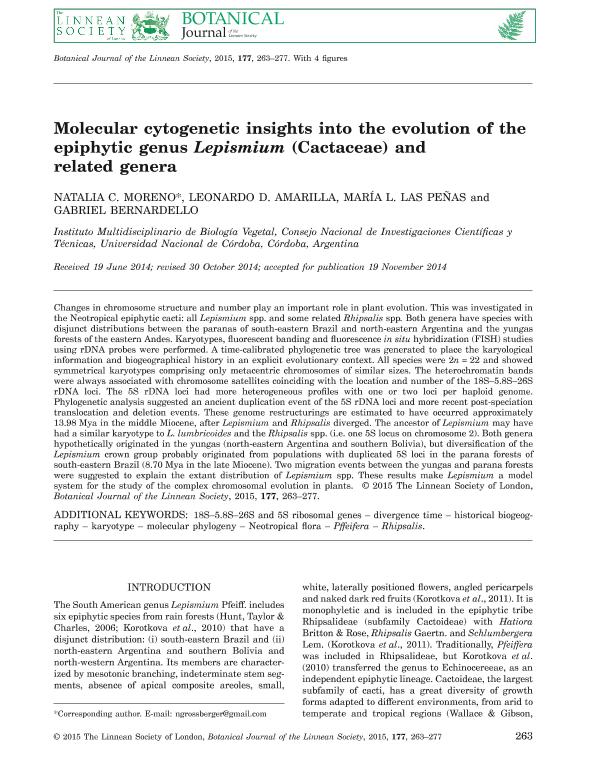Artículo
Molecular cytogenetic insights into the evolution of the epiphytic genus Lepismium (Cactaceae) and related genera
Moreno, Natalia Cecilia ; Amarilla, Leonardo
; Amarilla, Leonardo ; Las Peñas, Maria Laura
; Las Peñas, Maria Laura ; Bernardello, Gabriel Luis Mario
; Bernardello, Gabriel Luis Mario
 ; Amarilla, Leonardo
; Amarilla, Leonardo ; Las Peñas, Maria Laura
; Las Peñas, Maria Laura ; Bernardello, Gabriel Luis Mario
; Bernardello, Gabriel Luis Mario
Fecha de publicación:
02/2015
Editorial:
The Linnean Society of London
Revista:
Botanical Journal Of The Linnean Society
ISSN:
0024-4074
e-ISSN:
1095-8339
Idioma:
Inglés
Tipo de recurso:
Artículo publicado
Clasificación temática:
Resumen
Changes in chromosome structure and number play an important role in plant evolution. This was investigated in the Neotropical epiphytic cacti: all Lepismium spp. and some related Rhipsalis spp. Both genera have species with disjunct distributions between the paranas of south-eastern Brazil and north-eastern Argentina and the yungas forests of the eastern Andes. Karyotypes, fluorescent banding and fluorescence in situ hybridization (FISH) studies using rDNA probes were performed. A time-calibrated phylogenetic tree was generated to place the karyological information and biogeographical history in an explicit evolutionary context. All species were 2n = 22 and showed symmetrical karyotypes comprising only metacentric chromosomes of similar sizes. The heterochromatin bands were always associated with chromosome satellites coinciding with the location and number of the 18S?5.8S?26S rDNA loci. The 5S rDNA loci had more heterogeneous profiles with one or two loci per haploid genome. Phylogenetic analysis suggested an ancient duplication event of the 5S rDNA loci and more recent post-speciation translocation and deletion events. These genome restructurings are estimated to have occurred approximately 13.98 Mya in the middle Miocene, after Lepismium and Rhipsalis diverged. The ancestor of Lepismium may have had a similar karyotype to L. lumbricoides and the Rhipsalis spp. (i.e. one 5S locus on chromosome 2). Both genera hypothetically originated in the yungas (north-eastern Argentina and southern Bolivia), but diversification of the Lepismium crown group probably originated from populations with duplicated 5S loci in the parana forests of south-eastern Brazil (8.70 Mya in the late Miocene). Two migration events between the yungas and parana forests were suggested to explain the extant distribution of Lepismium spp. These results make Lepismium a model system for the study of the complex chromosomal evolution in plants.
Archivos asociados
Licencia
Identificadores
Colecciones
Articulos(IMBIV)
Articulos de INST.MULTIDISCIPL.DE BIOLOGIA VEGETAL (P)
Articulos de INST.MULTIDISCIPL.DE BIOLOGIA VEGETAL (P)
Citación
Moreno, Natalia Cecilia; Amarilla, Leonardo; Las Peñas, Maria Laura; Bernardello, Gabriel Luis Mario; Molecular cytogenetic insights into the evolution of the epiphytic genus Lepismium (Cactaceae) and related genera; The Linnean Society of London; Botanical Journal Of The Linnean Society; 177; 2; 2-2015; 263-277
Compartir
Altmétricas



